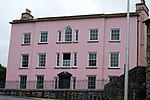Great House, Laugharne
Georgian architecture in WalesGrade II* listed buildings in CarmarthenshireHouses in CarmarthenshireLaugharne

The Great House in Laugharne, Carmarthenshire, Wales, is a Grade II*–listed early eighteenth century gentry residence in the Queen Anne style and is one of many buildings of note in the medieval township. The property was originally built with a central 'dog-leg' passage to the Double Pile plan with gable chimneys under two saddle roofs. Its interesting features include two carved round arches to the landing at first floor level, a small inset square-headed window to the central gable and an exceptional Baroque doorcase. The history of the house and that of its surroundings up to 1878 was chronicled by Mary Curtis.
Excerpt from the Wikipedia article Great House, Laugharne (License: CC BY-SA 3.0, Authors, Images).Great House, Laugharne
King Street,
Geographical coordinates (GPS) Address Nearby Places Show on map
Geographical coordinates (GPS)
| Latitude | Longitude |
|---|---|
| N 51.7724 ° | E -4.46317 ° |
Address
King Street
SA33 4QE , Laugharne Township
Wales, United Kingdom
Open on Google Maps








